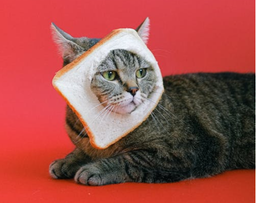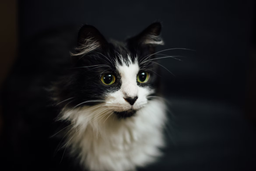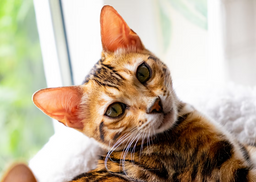How to choose the purrfect kitten food every time
If you’re new to cat parenting, you must be wondering what kittens eat and how often you should feed them. The process of choosing the right kitten food depends on whether your kitties have a mother. The weaning process is also a key factor since not all kittens start eating at the same time. Whatever the situation is, don't fret! With our tips and tricks, you will master kitten feeding in no time!
In this article, we will discuss different types of kitten food (such as wet and dry) and ways to choose the best tailor-made option for your furry companion.
Untamed helps you get all the kittens facts you need!

Are you done with the photoshoot? Can I eat now—I mean, meow?
Source: Freepik
What’s the first food to give to your kitty?
Your kittens’ first food depends on whether they have a mum. Mothers typically nurse their litter for eight weeks (which can extend to twelve weeks tops if a kitten is a slow weaner). If you’re fostering kittens, you should start with a nutritious formula or kitten milk replacer (KMR).
How to choose the right kitten formula
Once you go kitten food shopping, you’ll discover that there are numerous options to choose from. So, how do you know which one works best?
For starters, kitten formula comes in two forms:
- Powdered
- Canned
Many vets claim that canned KMR causes diarrhoea in kittens, so a powdered option seems to be a safer choice.
Now that you know which type of food to get, it’s time to dive into the nutrients. To support healthy growth, you should get KMR that complies with the following guidelines for basic nutrients:
|
Nutrient |
Minimum amount |
Recommended amount |
|
Protein |
35% |
More than 50% |
|
Fat |
12% |
Up to 20% |
|
Calcium |
0.8% |
1.6% |
You shouldn’t feed your kittens cow milk as it is incompatible with their natural diet and can cause dehydration and diarrhoea. Another potentially harmful item on the menu is raw meat because it may contain bacteria and cause stomach upsets and severe infections.
How to feed the formula to your kittens
Depending on your kittens’ age at the time of adoption, you can try feeding them with a syringe first and then switch to a bottle. To feed your kittens, you must:
- Combine one part KMR with two parts water
- Warm up the mixture to body temperature
- Hold the kitten firmly (NEVER feed them on their back). Try to mimic the position a kitten would be in if they were nursing. You can use your left hand to support their head or even wrap the kitten in a blanket to prevent them from wiggling around
- Slightly tilt the syringe or bottle and gently approach your kitten’s mouth. You want the kitten to latch on the makeshift nipple themselves. Don’t use force and squeeze the bottle because the kitten should eat at their pace. Forcing your kitten to eat could cause them to choke or get food in their respiratory system if the formula piles up around their mouth
How much should my kitten eat?
The amount of food your kitten needs depends on the food type and their body weight.
If you’re using kitten formula, you will need two tablespoons per 100 grams of their body weight. After weaning, kittens need around 60 calories per 450 grams of body weight until they reach 80% of full size, which is approximately when they are one year old.
Your kitten will gain around 10 grams of body weight every day, and it’s important to monitor those changes and weigh them daily to detect potential anomalies on time.
When do kittens start eating solids?
As your kittens grow, they will become more curious, and this will impact their food choices. Finally, around week five, your kittens’ teeth will start to emerge, and they will show interest in their mother’s food, and even yours, which means it’s time to start weaning.
The process of introducing your kittens to solids can last between three to eight weeks, depending on how cooperative your furballs are. For weaning, you can use:
- Wet food combined with KMR
- Dry food dampened with KMR, water, or chicken broth
- Homemade kitten gruel—essentially the same as the two options above, but softer and more palatable (kitten food blended with a source of moisture like water or chicken broth)
I’m going shopping for kitten food. What are my options?
Commercial kitten food typically comes in two forms:
- Wet kitten food
- Dry kitten food
Dry kitten food
When a kitten starts weaning, they need something to nibble on as their teeth are growing.
Many vets claim that a cat’s diet shouldn’t consist of cat kibble only because it is not as rich in moisture as wet food. You should also keep in mind that dry food has a maximum of 10% moisture, so keep that water bowl full and check up on your kittens to ensure they stay hydrated.
Dry kitten food is:
- Easier to store and has a longer shelf life
- Slower to spoil in the bowl (you can leave food for your kitten to eat whenever they want)
- Great for feline dental health
- Typically the cheapest option on the market
- Convenient to mix with liquids and other kinds of food to keep the diet versatile
Despite the alleged nutritional disadvantage, a kitten should have dry food occasionally because they will accept it more easily later on if they get used to the texture, and you won't end up with a fussy eater.
Wet kitten food
High-quality wet food is much easier to mix with formula and for kittens to nibble on and digest, making it the purrfect first solid food for kittens. It’s also:
- Soft and easy to munch on
- Appealing to kittens (because of its smell and texture)
- Nutritionally rich (the closest you can get to a wild cat’s natural diet)
- The best way to keep your kittens hydrated (with an average moisture content of 70%)
- Easy to serve because it usually comes in single-serve packaging
The slight price increase can be the deciding factor for some cat parents, but it pays off in the long run if you want your kitten to stay healthy and happy with the visits to the vet reduced to a minimum.
Most commercial cat food options come in jelly and gravy. Both are rich in moisture and nutrients, but some cats prefer the taste of the former and others of the latter.

Sometimes, when your pawrents don’t want to lower the bowl, you have to work around the issue!
Image (c) Untamed
What about prescription food for kittens?
Although its name suggests otherwise, prescription food for kittens does not require a prescription to buy it, but you should never put your kitten on a prescription or therapeutic diet before consulting your vet.
If you suspect your kitten is sensitive to particular types of food, talk to your vet about it because they know best! Introducing a restrictive or prescription diet before a diagnosis can potentially do more harm than good due to the lack of nutrients your kittens might need or a surplus of those they don’t. You should also refrain from putting kittens on a vegan diet because they won’t be able to develop properly.
Ingredients that should never be a part of your kitten’s diet
Besides knowing what's good for your kitten, it's essential to learn what's harmful. Cats are sensitive creatures and (because their organisms are designed to process meat and meat only) are intolerant to many human foods, such as:
- Raisins and grapes
- Raw dough and other products containing yeast
- Coconut flesh and milk
- Foods containing sugar, caffeine, or cocoa (such as coffee, chocolate, and green tea)
- Allium vegetables, such as shallots, onions, garlic, chives
- Citrus fruits (citric acid is harmful to cats)
- Skin and seeds of plums, pears, apples, and cherries (potential cyanide poisoning)
Whenever possible, keep dangerous products in airtight containers in places your kitten can’t reach (even if it means putting a padlock on cabinets). It’s always better to be safe than sorry when it comes to your kitten’s health.
What should I look for in kitten food?
With so many options available on the market, choosing the best kitten food can seem like a challenging task, but don’t stress about it! With our practical advice, you will know how to choose the best food for your kitten in no time!
Some kittens prefer wet food because of its texture, while others like dry food because of its taste. Whatever you go for, you should ensure it’s nutritious enough to support your furball’s rapid growth. Like KMR, kitten food needs to be rich in protein, fat, and other essential nutrients. Check out the table below for additional details:
|
Essential nutrients |
Description |
|
Vitamins |
|
|
Minerals |
|
|
Amino acids |
|
|
Fatty acids |
|
Grain can be part of your kitty’s diet but to a limited extent because too much of it can cause stomachaches, digestive problems, and weight gain. Consult your vet about switching to a grain-free diet if you notice your cat reacts badly to this ingredient.

Mum, didn’t you tell your kids not to play with their food? What’s this about now?
Source: Anna Shvets
Untamed—your kitty’s ally from kittenhood to the golden age
What if we told you that you could feed your kitten their favourite food their entire life? Our recipes are equally nutritious and delicious for cats of any age—kittens, adults, and seniors. Once your finicky little furball gets adjusted to Untamed, you won’t ever have to struggle when switching them from one food to another.
Take our quiz to get a meal plan designed according to your furry companion’s preferences!
What makes Untamed suitable for cats of all ages?
There is one nutritional requirement cats of all ages have in common—a large amount of high-quality animal protein. We provide it by picking only the best human-grade ingredients. Depending on your kitten’s preference, you can let them choose between:
- Chicken (breast and liver)—alone or combined with ham or duck
- Fish—our recipes consist of the most delicate mackerel, tuna, and salmon
- Seafood—our Tuck-in Tuna with Shrimp will win the hearts of any gourmet cat who is fond of seafood
Our ingredients are ethically and sustainably sourced because we care for our furry friends and the planet we share.
16% of crude protein and an astounding average of 80% of moisture in our vet-formulated recipes will keep your kitten full and hydrated at all times. Does your kitty need an extra kick in calories? Try mixing our meals with some dry food to get that weight gain going.

One charcuterie to rule them all!
Image (c) Untamed
What are the pawesome benefits of feeding your kitten Untamed cat food?
Untamed is beneficial for kittens and cat parents in many ways! Let’s take a look at what our kindle members have to say about switching to our meals:
|
Benefits for cat parents |
Benefits for cats |
|
|
How to get your purrfect Untamed starter pack
We strive to make the Untamed experience purrfectly seamless for our clients. All you need to do to get tailor-made cat food delivered to your doorstep is:
- Open our Try Now page
- Tell us about your furry friend—What’s their name? What do they like to eat? How much do they eat daily?
- Select a meal plan and place your order
You’ll get the taster pack in no time, so your cat can sample our dishes and choose the one they like. It is not final—if you’re not happy with the particulars of your intitial cat food subscription, including the delivery date and meals included—you can always change it!

We wants it. We needs it.
Image (c) Untamed
Your kitten is fussy and won’t eat?
Is your kitten a stubborn and persistent weaner? Or do they throw a tantrum when they get the same food over and over again?
Don’t worry if your kitten is picky because there is an easy way to work around the issue and get your kitty back on track nutrition-wise.
Fussy kittens—the right approach makes all the difference
Before changing your kitten’s food, try making it more appealing to your furball with one of these methods:
- Warm up your kitten’s food—Do you hate eating cold food? Some kittens share the same aversion! Your kitten might refuse eating anything until you warm it up to body temperature (around 37 degrees)
- Mix wet and dry food—The difference in textures and the enhanced smell of both types of food might intrigue your kitten. They will enjoy the nutritional benefits of both variants
- Add some broth or water to your kitten’s dry food—Your kitten needs moisture in their food, and you can provide it while also dealing with their picky tendencies! Broth and water will keep your kitten hydrated
Sometimes, it’s not the kitten food causing trouble
Your kitten might reject food even if it’s their favourite kind. Despite your best efforts to pick the best product for your little furry friend, they will refuse to eat it if:
- The feeding area is too close to the litter box—You wouldn’t eat near the toilet, either, would you?
- Other pets are circling around your kitten’s food bowl—Kittens can have a hard time adjusting to other pets, especially if they show aggression and territoriality towards the new addition to their family
- The noise level is high—Loud noise can scare your kitten and potentially harm their hearing
- They were suddenly weaned—Kittens taken away from their mum abruptly can have trouble eating solids because they have no clue what to do, and they miss their mother

Joey doesn’t share food!
Image (c) Untamed
Why you need to act immediately if your kitten rejects food
Picky kittens can quickly lose weight, and you must prevent that at all costs. Kittenhood is the period of growth, and any weight loss could negatively affect their development and maybe even have a fatal outcome.
Is your kitten still avoiding food? Maybe it’s time to ask for professional help
Unfortunately, it can be challenging to determine why your kitten refuses to eat. If they don't take any food for 24 hours, you should take them to the vet.
Let’s take a look at the most common reasons why a kitten refuses to eat and what the potential consequences are:
|
Reasons why a kitten won’t eat |
Symptoms that might occur with food rejection |
Consequences |
|
|
|

![Best food for Ragdoll cats in the UK [Broken Down]](http://untamed.com/cdn/shop/articles/featured_best_food_for_ragdoll_cats_uk.jpg?v=1646818249&width=256)

